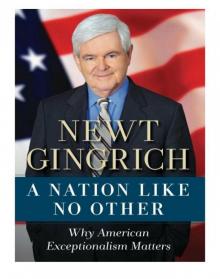- Home
- Newt Gingrich
Trump's America Page 4
Trump's America Read online
Page 4
However, the percentage of immigrants in the United States was at an all-time low of 4.7 percent in 1970, and then it nearly tripled in 45 years. The actual number of immigrants in the United States has also more than quadrupled in that time frame, going from 9.6 million to an all-time high of more than 43.2 million.
Critically, because we have moved away from the melting-pot model, many of these new immigrants were not expected to learn our language, customs, or traditions, and therefore never assimilated into American society.
Consider the following:
• In Miami, 60 percent of the population speaks Spanish8 due to large immigrant populations from Cuba, Colombia, Guatemala, Honduras, Nicaragua, and Venezuela.9 Native, English-speaking business owners there say it has become difficult to conduct business. For the entire state of Florida, the foreign-born population increased by 60.6 percent from 1990 to 2000, and again by 53 percent from 2000 to 2015.10
• The radio program This American Life aired a show in December 2017 telling the story of Albertville, Alabama—the hometown of Attorney General Jeff Sessions. The population in Albertville shifted from 98 percent white to one-quarter Latino in a matter of two decades starting in 1990. Some of the Latinos interviewed had lived in the United States for 20 years and still did not speak English well enough to be interviewed in what is supposed to be our common language.11
• In Minneapolis, the Somali immigrant population exists in a neighborhood dubbed “little Mogadishu” that is completely isolated by the Mississippi River and two highways. I visited there while researching my novel Duplicity. The community first started growing in the 1990s. Importantly, from 2007 to 2013, more than 20 young Somali men left the community to go fight for al-Shabab, a jihadist group in East Africa.12 Now, the community itself has programs to keep young men away from street gangs as well as Islamic radicalization. The area has always been an immigrant community, however, the Germans and Swedes who preceded the Somalis decades before assimilated.
These are all examples of immigrant populations coming to the United States and re-creating small versions of their home countries rather than becoming American. While this may seem innocuous, it can present real challenges for police and local officials—especially if these mini-nation communities grow large and isolated.
And the problems can go both ways. In some isolated immigrant communities, language barriers prevent victims from reporting crimes to police—or even calling 911 for medical assistance.13 For police investigating crimes in immigrant communities, it can become almost impossible to gather critical witness testimony—either due to a language barrier or a mistrust of American law enforcement.
When you consider that many Americans voting today have lived in an America that quickly went from having near record-low to near record-high immigrant populations (relative to the total population)—and at the same time watched the American approach to immigration profoundly transform, creating isolated immigrant communities—it is easy to see why people are concerned. It is easy to understand why the Trumpian approach to immigration and assimilation gained support.
Despite media claims, the members of Trump’s America are not anti-immigration. We are against illegal immigration. We cannot attract the best and the brightest from across the world if we cease to be a nation of immigrants. However, a key part of the great American comeback involves reestablishing the melting-pot model and getting immigration laws and enforcement under control. This will do wonders for easing tensions and negative perceptions about immigration.
MULTICULTURAL DIVISION
The shift toward multiculturalism over the melting pot has affected more than immigration. The salad bowl model has actually worsened race relations by separating American culture, diminishing our common ground, and ultimately stratifying our citizenry at home by establishing a system in which people self-segregate based on their ethnicity, gender, self-identity, or perceived privilege.
In his 2012 essay, Thornton from the Hoover Institution warned that the salad bowl theory provided the foundation of the identity politics, which drives much of the cultural upheaval in America domestically today. Specifically, he argued that multiculturalism has been used to indict American society as “imperial, colonial, xenophobic,” and racist.
According to Thornton, this theory ultimately provides justification for placing the rights of some groups above others—based on the degree to which they had been supposed victims of the newly vilified American history. This, as Thornton wrote, “directly contradicts the core assumption of our liberal democracy: the principle of individual and inalienable rights that each of us possess no matter what group or sect we belong to.”
Once again, the purpose behind identity politics seems innocent. Indeed, appreciating and understanding different peoples’ perspectives is critical for building strong relationships—particularly across cultural or societal lines. However, today’s identity politics seem to have gone awry. Instead of promoting a noble pursuit of equality and understanding, multiculturalism and identity politics have led us into a perverse paradigm of privilege checking.
Instead of judging various points of view on merits, speech and debate are frequently tested and measured based on the ethnicity, gender identity, or sexual orientation of the speaker. Speakers from minority backgrounds, or those with uncommon sexual identities, are uplifted, while those who are deemed to have more privilege are silenced—unless they confess their privilege and preemptively repudiate the validity of their points of view.
Take this way of thinking and consider how it’s used in current politics. Think about how often President Trump has been described as an older white male by elites who were seeking to discredit his positions and goals. Notice, this “criticism” does not address anything about the president’s agenda or goals; it simply seeks to imply that he is in the old white male group and therefore couldn’t possibly be interested in helping any other group. Not coincidentally, the exact same tactic was used against Bernie Sanders in the Democratic primary.
The privilege theory system does not engender equal and free debate. Nor does it promote the sharing of new ideas. It attempts to divide us into vaguely ranked groups to establish a pseudo hierarchy of entitlement for a minority of Americans. Frankly, it reminds me of George Orwell’s novel Animal Farm, in which “All animals are equal, but some animals are more equal than others.”
In fact, the relevance of Orwell’s writing is important in understanding the genuinely radical nature of privilege theory. Orwell was an opponent of communism, a governing system derived from the writings of Karl Marx, and his stories were illustrations of the corruption and moral bankruptcy of that totalitarian philosophy.
As Canadian professor Jordan Peterson has pointed out in a series of YouTube lectures and interviews, privilege theory began to emerge around the time that news of the evil communist Soviet Union became too visible to be ignored by the intellectual class. The reaction from this elite, however, was not to question the underlying philosophy of Marxism, which sought to pit the proletariat against the privileged economic elite, but instead to replace economic dividing lines for racial ones. Privilege theory is, in fact, nothing more than racial Marxism, and left unchecked will lead to the same disastrous, totalitarian end state as the Soviet Union.
Privilege theory in practice is also a complete departure from what Dr. Martin Luther King Jr. envisioned in his “I Have a Dream” speech. The privilege theory system clearly judges people “by the color of their skin” rather than “the content of their character.”
Consider the following examples of privilege-based identity politics in action.
In May 2017, students rioted several times after faculty at Evergreen State College in Olympia, Washington, declined to enforce a student demand that would require white students to stay home from class for a day. This day without white people was reportedly in the name of racial equality. The violence got so bad the college had to hold its graduation ceremony off campus, 30 miles awa
y.14
During the 2017 Democratic National Convention candidate forum, candidate Sally Boynton Brown, who is the executive director of the Idaho Democratic Party, said that her purpose at the forum was “to listen and be a voice and shut other white people down” when they deny being prejudiced.
The Atlantic published a story in September 2015 that declared, “Color-Blindness Is Counterproductive.” The magazine cited sociologists who have decided colorblind theory is just a covert way to ignore racial discrimination.15
As a final example, a professor at City University of New York in October 2017 posted a series of tweets in which she claimed that when white families have children, they are promoting systemic white supremacy.16
Specifically, the professor, a white woman, wrote: “I mean, if you’re a white person who says they’re engaged in dismantling white supremacy but… you’re forming a white family + reproducing white children that ‘you want the best for’—how is that helping + not part of the problem?”
All of these examples fit the Thornton model. The rights of some people are diminished, and others are uplifted in the name of America’s supposedly racist, iniquitous past—for which no people alive today are responsible.
President Trump is working to dismantle this perverse social reconstruction and return our politics and country to a system in which people are treated with equal respect and ideas are judged by their merits rather than the race, gender, ethnicity, or so-called privilege of the people who share them.
Unfortunately, the liberal members of the anti-Trump coalition have latched on to identity politics as a way to isolate and target particular voter groups. It is unclear how this tenuous culture of coalition building will last. As I wrote in my New York Times No. 1 best seller Understanding Trump, the Left misunderstood the coalition-building success Barack Obama achieved in his 2008 and 2012 elections. While Obama was able to unite many demographic groups on core American principles, today’s Left is promoting divisive politics in an effort to hold these groups together.
It clearly did not work for them in 2016. We will see if they continue sowing disunity ahead of the 2018 midterm elections.
SEGREGATING THE MELTING POT
A final side effect of multiculturalism which has arisen in American society is the idea that someone from one culture cannot adopt some aspect of another culture. To do so, the liberal branch of the anti-Trump coalition argues, is “cultural appropriation.”
There are plenty of absurd examples, such as the Portland burrito truck that was shamed out of business in May 2017 after its owners were accused of culturally appropriating the burrito. Cosmopolitan magazine in October 2017 also decided to inform white parents they should not allow their daughters to dress up as Disney’s Moana for Halloween because they would be appropriating Polynesian culture.
Certainly, it is socially unacceptable and morally repugnant for someone to don blackface and denigrate African Americans. Similarly, displaying insulting depictions of people from other cultures or societies falls far short of the shining city on a hill standard.
However, raising pitchforks over white northwestern liberals eating burritos or children admiring and wanting to emulate fictional characters from other (often fictional) countries is ridiculous.
Still, this notion of cultural appropriation is serious because it is an absolute repudiation of the melting pot. If cultures are not socially allowed to blend and adopt new ideas and customs, then the United States will become a collection of isolated, fragmented communities that have little in common. Certainly, had the Founding Fathers believed that it was morally wrong to experience and share new cultures, America would have never been formed.
After all, democracy was culturally a Greek invention—are all democratic countries essentially stealing from Greece? Our representative Republic has roots in Rome. Should we give our Senate back to Italy? Is there a moral imperative that we stop celebrating Cinco de Mayo or St. Patrick’s Day—or stop using French, Spanish, or Germanic words that have become English cognates?
The ultimate destination of the multicultural movement in the United States is actually a new era of American segregation. The idea that we can survive as a nation without a unified culture that is grounded in principles rather than heritage is just historically and logically inaccurate. Further, America is a better place (both for immigrants and citizens) when we share common ground and mutual respect rather than picking fights over magnified and often artificial differences.
If we in Trump’s America are to complete this great American comeback that the 2016 election started, we must seriously focus as a nation on reestablishing the melting-pot principle that helped us succeed for more than 240 years. It is essential for American culture to continue—and American culture is essential for our country’s survival. That is the heart of the Trump appeal.
SECURING THE BORDERS
President Trump has consistently said he supports strong immigration programs that will help America grow and succeed for generations to come. However, the president knows that new immigration laws would be meaningless without safe, secure borders.
The people of Trump’s America know it, too.
This is why many Americans have responded positively to President Trump’s calls to tighten security at our borders, curtail illegal immigration, and to closely vet refugees coming to the United States from war-torn countries rife with terrorism.
However, throughout 2017, congressional Democrats, federal bureaucrats, leaders in so-called sanctuary cities, and special interest groups have fought tooth and nail to slow construction of the southern border wall, hinder lawful immigration enforcement, and halt temporary travel bans issued by the Trump administration.
In following with the multicultural-privilege theory model, the elites in the anti-Trump coalition have claimed that President Trump’s tough positions on immigration are driven by inherent racism—which they insinuate carries over to all members of Trump’s America. This assertion is morally bankrupt and reveals a profound historical (perhaps intentional) ignorance on their part.
This assertion also ignores the facts on the ground. President Trump’s immigration plans are succeeding.
Despite the efforts of the elites, illegal crossings (as well as human trafficking) over the southern border are down,17 and the U.S. Supreme Court ruled in December 2017 that a third version of a temporary ban on travel to eight dangerous nations could proceed over aggressive legal challenges.18
The impact President Trump had on illegal immigration was almost immediate. In May 2017—less than five months into the president’s term—National Public Radio reported on Morning Edition that, “The number of people apprehended while trying to cross the Southwest border illegally has plummeted, as the age-old practice of hopping the border without papers has changed profoundly in recent months.”
This near-immediate drop in illegal crossings was due to increased security at the U.S.–Mexico border—but also due to the message President Trump’s election sent around the world: that immigration laws in the United States meant something again.
The reduction in demand for immigrants to illegally come to the United States had the added benefit of also drying up some illegal activity in Mexico. One human smuggler the news outlet interviewed, who called himself “the Wolf,” was quoted saying, “My business has dropped by more than half.… If it goes down anymore, I’ll have to think about doing something else. Maybe open a little store or sell cars.”
Imagine that. Trump’s ability to reduce human trafficking may lead some criminals to take up honest trades.
Despite this direct connection between increased security and decreased illegal crossings, the Washington elites are still fighting the president’s policy goals. As of the end of Fiscal Year 2017, total apprehensions of unattended immigrant children were down from 2016 by 30 percent—from 59,757 to 41,456. Apprehensions of accompanied children, parents, and or guardians was down 2.6 percent—from 77,857 to 75,802.
&n
bsp; I’m confident President Trump will build the wall—and reestablish law and order at the border. Once security is achieved, he will further work to reestablish policies to promote assimilation and reassert that the United States is one, indivisible nation including those who come here legally and want to become Americans.
CHAPTER THREE
THE COMEBACK OF “UNDER GOD”
In addition to reaffirming that the United States is one, indivisible nation, the Trump comeback is also about reestablishing America as a nation under God.
President Trump gave his most illustrative speech on the importance of religious freedom in the first days of his presidency, when he spoke at the annual National Prayer Breakfast on February 2, 2017.
In his remarks, the president said, “America is a nation of believers. In towns all across our land, it’s plain to see what we easily forget—so easily we forget this—that the quality of our lives is not defined by our material success, but by our spiritual success.”1
Shortly after this speech, President Trump signed an executive order to protect the rights of America’s believers, which instructed executive branch employees to promote free speech and religious liberty in their duties.2
This order was necessary because the Obama administration had consistently used the power of the government to diminish religious freedom. Obama aggressively struck down regulations that would have protected religious groups from paying for health care coverage for procedures which they opposed on moral grounds. His Department of Homeland Security also produced a report on “right-wing extremism” identifying pro-life advocates and other traditional conservatives as “extremists.”
Reversing the Obama anti-religious pattern, President Trump in May 2017 signed an order instructing government personnel that, “It shall be the policy of the executive branch to vigorously enforce Federal law’s robust protections for religious freedom.”

 1945
1945 Collusion
Collusion Trump's America
Trump's America Shakedown
Shakedown A Nation Like No Other
A Nation Like No Other To Try Men's Souls - George Washington 1
To Try Men's Souls - George Washington 1 Pearl Harbor: A Novel of December 8th
Pearl Harbor: A Novel of December 8th Valley Forge: George Washington and the Crucible of Victory
Valley Forge: George Washington and the Crucible of Victory To Save America
To Save America Grant Comes East cw-2
Grant Comes East cw-2 Victory at Yorktown: A Novel
Victory at Yorktown: A Novel Days of Infamy
Days of Infamy The Battle of the Crater: A Novel (George Washington Series)
The Battle of the Crater: A Novel (George Washington Series) Breakout: Pioneers of the Future, Prison Guards of the Past, and the Epic Battle That Will Decide America's Fate
Breakout: Pioneers of the Future, Prison Guards of the Past, and the Epic Battle That Will Decide America's Fate Pearl Harbour and Days of Infamy
Pearl Harbour and Days of Infamy Pearl Harbour - A novel of December 8th
Pearl Harbour - A novel of December 8th Understanding Trump
Understanding Trump To Save America: Abolishing Obama's Socialist State and Restoring Our Unique American Way
To Save America: Abolishing Obama's Socialist State and Restoring Our Unique American Way